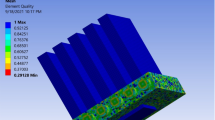Abstract
This chapter deals with comparison of heat transfer performance of rectangular and circular mini channels liquid heat sink for cooling of real Insulated Gate Bipolar Transistor (IGBT) module. A three-dimensional steady-state simulation using Ansys Icepak is implemented for this investigation. In this chapter, IGBT module- SKM75GB12T4 made by SEMIKRON is used. The IGBT module is made of multilayers, in which a power of 200 W is dissipated on the silicon diode chip. Water as a coolant is passed through the mini channel at an inlet temperature of 305 K for different values of Reynolds numbers (396 to 989). It is observed that the heat transfer performance of rectangular channels is always better than that of circular channels both in terms of baseplate and junction temperature because the surface area to cross-sectional area ratio is higher in case of rectangular channels. Further, the aspect ratio of rectangular channel is varied in a range of 0.8–1.6 at different Reynolds numbers (396–989). A higher aspect ratio confirms better heat dissipation, although at higher Reynolds number (Re > 700) baseplate temperature is insensitive to the aspect ratio of the mini channel. Thermal resistance for rectangular and circular mini channel is obtained and its variation with channel height is also analysed. It is found to have lower thermal resistance in rectangular channel than circular. Results have shown lower thermal resistance with higher mini channel height. As per the requirements of junction to case thermal resistance value of 0.38 K/W provided by the manufacturer for safe operation of the IGBT, a rectangular mini channel with aspect ratio of 1.5 at Reynolds number of 989 gave the thermal resistance value of 0.39 K/W.
Access this chapter
Tax calculation will be finalised at checkout
Purchases are for personal use only
Similar content being viewed by others
Abbreviations
- AR:
-
Aspect ratio
- H:
-
Height of mini channel (m)
- Q:
-
Power supplied (W)
- Rth:
-
Thermal resistance (°C/W)
- Tj:
-
Junction temperature (°C)
- Tin:
-
Inlet temperature of water (°C)
- W:
-
Width of mini channel (m)
References
Electronics cooling methods for PCB thermal management, system analysis blog, Cadence
Tuckerman DB, Pease RFW (1981) High-performance heat sinking for VLSI. IEEE Electron Device Lett 2(5):126–129
**e XL, Tao WQ, He YL (2007) Numerical study of turbulent heat transfer and pressure drop characteristics in a water-cooled minichannel heat sink. J Electron Packaging 129(3):247–255
Jajja SA, Ali W, Ali H, Ali A (2014) Water cooled minichannel heat sinks for microprocessor cooling: effect of fin spacing. Appl Therm Eng 64(1–2):76–82
Shi M, Yu X, Tan Y, Wang X, Zhang X, Li J (2022) Appl Therm Eng 201:117718
Mohammadi M, Taheri A, Passandideh-Fard M, Sardarabadi M (2020) Electronic chipset thermal management using a nanofluid-based mini-channel heat sink: an experimental study. Int Commun Heat Mass Transfer 118(September):104836
SKM75GB12T4—Semikron—IGBT Module, Half Bridge, 115 A.
Sohel MR, Khaleduzzaman SS, Saidur R, Hepbasli A, Sabri MFM, Mahbubu IM (2014) An experimental investigation of heat transfer enhancement of a minichannel heat sink using Al2O3-H2O nanofluid. Int J Heat Mass Transfer 74:164–172
Naqiuddin NH, Saw LH, Yew MC, Yusof F, Ng TC, Yew MK (2018) Overview of micro-channel design for high heat flux application. Renew Sustain Energy Rev 82:901–914
Soudagar M, Kalam MA, Sajid M, Afzal A, Banapurmath NR, Akram N, Mane SD, Saleel A (2020) Thermal analyses of minichannels and use of mathematical and numerical models. Numer Heat Transfer Part A Appl 77(5):497–537
Acknowledgements
The authors acknowledge the High-Performance Computing Facility provided by IIT Roorkee to carry out the computational work.
Author information
Authors and Affiliations
Corresponding author
Editor information
Editors and Affiliations
Rights and permissions
Copyright information
© 2024 The Author(s), under exclusive license to Springer Nature Singapore Pte Ltd.
About this paper
Cite this paper
Koch, P., Singh, A., Subudhi, S. (2024). Flow and Heat Transfer Investigation of Liquid Heat Sink for an IGBT Module. In: Singh, K.M., Dutta, S., Subudhi, S., Singh, N.K. (eds) Fluid Mechanics and Fluid Power, Volume 1. FMFP 2022. Lecture Notes in Mechanical Engineering. Springer, Singapore. https://doi.org/10.1007/978-981-99-7827-4_50
Download citation
DOI: https://doi.org/10.1007/978-981-99-7827-4_50
Published:
Publisher Name: Springer, Singapore
Print ISBN: 978-981-99-7826-7
Online ISBN: 978-981-99-7827-4
eBook Packages: EngineeringEngineering (R0)




